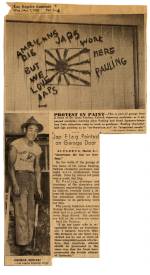|
On a March morning in 1945, Linus and Ava Helen Pauling’s young son Peter ran into
the house and told his parents, "You’ve got to come out here and look. Someone’s painted
stuff on our garage." The Paulings were appalled by what they saw. Someone had defaced
their home, scrawling "AMERICANS DIE BUT WE LOVE JAPS" below a crudely drawn Japanese
flag. "JAP" was grafittied on their mailbox. When police and reporters arrived, an
outraged Pauling told them that the painting was probably a response to the Japanese-American
man the Paulings had hired as a gardener for a weekend, a gesture of friendship for
a young soldier on his way to report for duty in the Army. Pauling then compared the
vandalism, "this un-American act," as he called it, to the persecution of Jews by
the Nazis. It was the beginning of a major change in his life. The World War II battle
against Japan was still being fought, and many Americans were dying. After the newspaper
published his thoughts, the Paulings started to receive hate mail and whispered, anonymous
death threats over the phone. The family was frightened. When a local sheriff refused
to post an armed guard around his house when Pauling was away, Ava Helen called the
local chapter of the ACLU (a group with whom she’d been working in the fight against
the internment of Japanese-Americans during the War) and asked for help. ACLU pressure
resulted in the posting of a guard, and things soon calmed down.
There were no more incidents. But Pauling was deeply affected by this threat to his
family. He was a patriot and a supporter of the US government. He had helped fight
against his country’s enemies in World War II by leading research projects to develop
better explosives and rocket propellants. But now he had seen a different side of
America. Now he had seen intolerance first-hand. He had seen a lawman who had to be
forced to uphold the law. He had seen a liberal legal group, the ACLU, successfully
spur positive change. His wife Ava Helen had always said that there were pressing
issues of social justice in the nation that needed more attention. After the incident
Pauling began to listen to her ideas more closely.
|
|
Click images to enlarge

"Jap Flag Painted on Garage Door." March 7, 1945.

Transcript of an anonymous letter sent to Linus Pauling. March 9, 1945.
"December 8, 1941 was a memorable day on the normally quiet Caltech campus....At 10
a.m. we dutifully assembled in Culbertson Hall where our registrar, in full National
Guard uniform complete with pistols, gave a most intemperate speech about the dastardly
‘Japs’....Linus Pauling was standing in the back of the hall...and interrupted the
speech by bursting out with the question, ‘By what authority have you called this
impromptu convocation?’ He then proceeded to remind the registrar that Caltech was
known for being a place of thoughtful and factual reason, but the registrar had turned
it into a place of pure hysteria. The student body stood up and clapped for Linus.
The registrar dismissed the meeting and retreated in some disarray."
|

